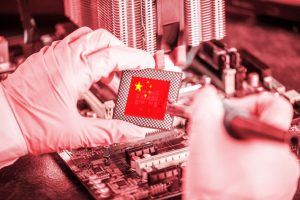Suzhou, a city west of Shanghai, is known for its canals, bridges and classical gardens. It is also home to the world’s largest nanotech industrial zone, called ‘Nanopolis.’
This futuristic city houses several private multinationals and new Chinese startups across different fields of nanotechnology and nanoscience. Needless to say, China leads the world’s nanotech startups, according to a report in Small Wars Journal.
From cloning to cancer research, from sea to space exploration, China is using nanoscience and nanotechnology innovation to drive some of the world’s biggest breakthroughs, which is raising concerns in many other competing countries.
Also on AF: China Evergrande Says Banks Seized $2.1bn: Tweet of the Day
In fact, the situation has become so alarming, the US National Science Board’s warned in a recent report – State of US Science and Engineering 2022 – that China is pulling ahead of the United States when it comes to key indicators of science and engineering prowess.
“S&E investments and capabilities are growing globally and, in some cases, the growth in other countries has outpaced that of the US,” said Ellen Ochoa, chair of the board.
The nation is falling behind China in important areas such as growth in research-and-development investment, the manufacturing of critical emerging technologies and patents for innovative systems, National Defense reported.
China contributed 29% of the growth in global research and development between 2000 and 2019, compared to the United States’ 23%, according to the report.
Beijing is also leading the United States in knowledge- and technology-intensive, or KTI, industry manufacturing, although the United States is the largest producer of KTI services, Ochoa said during a press conference with reporters in January, National Defense reported.
KTI is defined as industries that globally have high rates of R&D. Such industries “develop and deploy many of the critical and emerging technologies essential for current and future competitiveness,” she said.
In terms of US national security, it is problematic if the manufacturing of certain critical technologies is concentrated in an adversarial country.
“It is an area of concern,” admitted Julia Phillips, chair of the National Science Board’s Science and Engineering Policy Committee.
“[But] it would be the height of hubris to think that [the United States] would [continue to] lead in everything,” Phillips said.
US Tax Barriers to Investment
According to Breaking Defense, China’s R&D spending in 2020 totalled $378 billion, or 2.4% of its gross domestic product, which is a record high.
At a time when R&D is so crucial to future economic growth, the US appears to have shot itself in the foot.
Incentives are the key to innovation and have been instrumental to America’s technological superiority for generations. Many of these incentives are built into America’s tax system, which has proven to be an influential tool in spurring innovation.
However, an IRS tax law change that went into effect on January 1 is now a major disincentive to private investment in R&D, Breaking Defense reported.
Since the 1950s, businesses have been able to deduct qualifying US R&D expenditures for federal tax purposes in the year they were incurred.
In January, these incentives dramatically changed. Now companies of all sizes – including eligible startups – must spread or amortize these costs over five years.
Meanwhile, the Chinese government is doubling down on incentives for innovation, which it believes to be the cornerstone of its future growth and international position, Breaking Defense reported.
As such, it has designed a strategic incentive regime with the goal of fast-tracking indigenous technological advancement and propelling its economy even further.
US Share of Patents Falls
In contrast to US companies, that means for every $100 spent to innovate, Chinese companies can deduct $200, ten times more than American ones can.
The US share of international patents has also declined from 15% to 10% between 2010 and 2020. China, meanwhile, increased its share from 16% to a whopping 49% in that same timeframe.
It doesn’t take a rocket scientist to see where this is going – China aims to dominate the world on the tech front, and they are reaching a tremendous apex in R&D spending and research.
The latter has already led to several notable achievements.
In June 2020, an international team of researchers led by Chinese scientists developed a new form of synthetic and biodegradable nanoparticle, Small Wars Journal reported.
This modifiable lipid nanoparticle is capable of targeting, penetrating, and altering cells by delivering a gene-editing tool into a cell. This novel nanoparticle can be used in the treatment of some gene-related disorders, as well as other diseases including some forms of cancer in the brain, liver, and lungs.
At the State Key Laboratory of Robotics in the northeast city of Shenyang, researchers have developed a laser that produces a tiny gas bubble, Small Wars Journal reported.
This bubble can be used as a tiny ‘robot’ to manipulate and move materials on a nanoscale with microscopic precision. The technology termed as ‘Bubble bot’ promises new possibilities in the field of artificial tissue creation and cloning.
China’s Printing Industry Breakthrough
One of the major breakthroughs in Chinese nanotech research is expected to lead a green revolution in the printing industry.
A new nanomaterial invented by researchers from the Institute of Chemistry under the Chinese Academy of Sciences (CAS) has demonstrated the potential to effectively eliminate millions of metric tons of liquid pollution and emissions from organic chemicals used in printing plates and ink, which are quite dangerous to human health.
Chinese universities are increasingly becoming a pre-eminent source of R&D, and that could affect the decision making of some students who otherwise would study in the US.
Prominent universities like Peking University, City University of Hong Kong, Nanjing University, Hong Kong University of Science and Technology, Soochow University and the University of Science and Technology of China are the leading institutions that house state of art nanotech research labs, Small Wars Journal reported.
“China, which is our largest source of foreign talent in the graduate schools, has outstanding opportunities for many of its own students to stay right at home and have a great education and a great career,” Phillips told National Defense.
The US must “continue to be attractive for the best and brightest, wherever they come from, to come to this country and contribute their S&E talent to our own pool,” she said.
- By Dave Makichuk
Read more:
China Tech Crackdown Seen ‘Just Getting Started’ on Data
Taiwan Takes Legal Route To Protect Itself From ‘China Tech Theft’
China Biotech Firms Stunned by US Drug Trial U-Turn
























